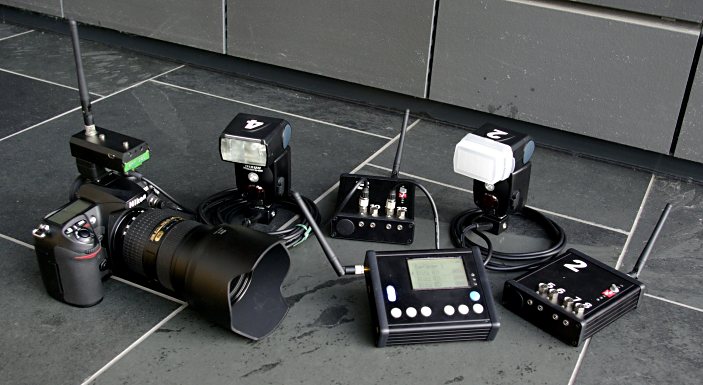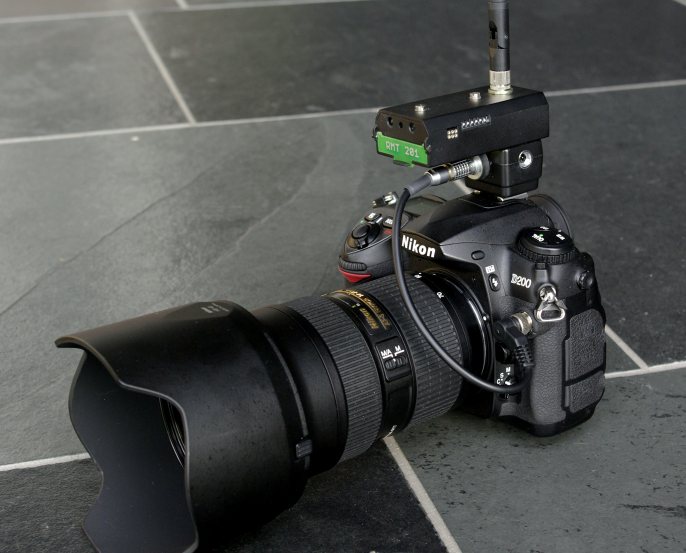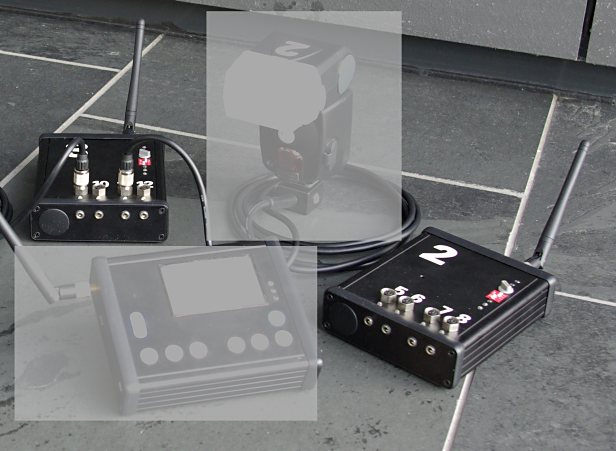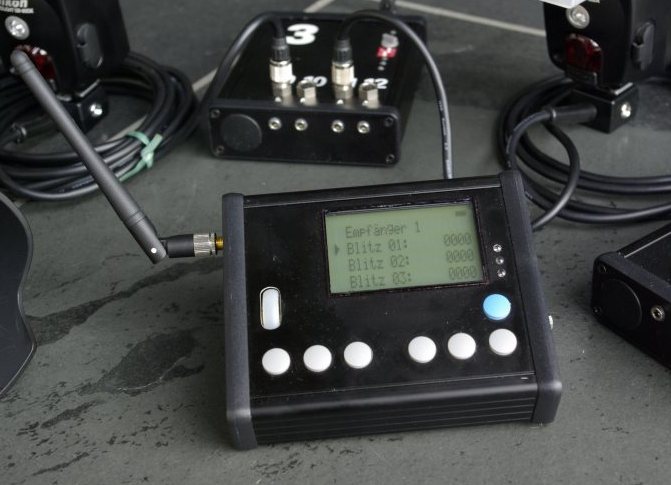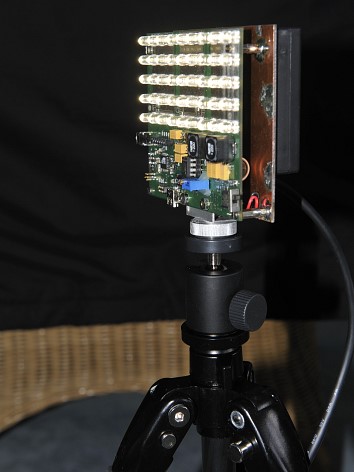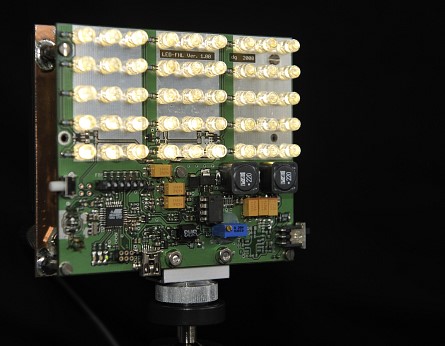A
wireless RF remote control system
for Nikon compact flashes
![]() < für
deutsche Version hier klicken
< für
deutsche Version hier klicken
©
Dirk Gottschalk 2009
This
Version does not exist any more. There is a new System
2
now.
(German
language only at the moment)
I
would like to present a "small" hobby project here on
which I was working for over a year:
A radio frequency
remote control system for Nikon flashes
Why
that? Are'nt there appropriate solutions
out there?
May be this solution is a little bit special because
of my situation. I don't own a car and therfore I cannot carry
large studio flash equipment or even 'porties' with me. Everything
has to fit into my bags and thus the whole stuff has to be very
compact and light weighted. So I decided to buy a little zoo of
SB-80DX flashes and control them remotely. One SB-800 I already
had.
With
my RF solution I not only can trigger the flashes, additionally
I can control power, wakeup from standby or let them work as
stroboscope. 'Ready' signal is processed so that the receivers will
tell me when all flashes are ready to trigger again.
The
flashes are connected via cable with AS-10 heads to the flashes.
Four 3,5mm phono jacks exhibit connectivity for non-Nikon flashes,
but these only can use the trigger and quench signals then.
My
system consists of a transmitter, plugged onto the camera, three
receiver units (could be seven) and the controller unit.
The
system is based on 433MHz RF modules. Although there is lot of other
stuff working and disturbing in this frequency range I decided to
use them because of there extremely short latencies. Short latency
was important for me to get realy fast synchronisation response
time. My system can trigger the flashes even in a 1/250 second window!
The system provides seven channels plus one broadcast channel. It can address seven receivers (plus one address for all receivers). Each receiver can control four flashes, 28 in total. The power of every single flash can be configured individually.
Rf transmission is hamming coded. Although no error correction is provided, errors can be detected so that theoretically no unwanted trigger pulses can occur. By the nature of this RF technique missing triggers cannot be avoided.
All units are powered from Nikon EN-EL4 batteries, so power should'nt be an issue at all. Additionally all batteries are protected against under voltage discharge. Besides the receiver and controller units contain battery chargers which can be fed by any power supply with output voltages between 6...12 Volts.
The Transmitter
The
transmitter on the camera triggers the flashes fast enough to catch even
a 1/160 sec window.
If the transmitter is connected via a little
adapter cable to the remote connector of the camera, the synchronization
time may be even as short as a 1/250 second. This works by detecting
the first push point on the camera shutter release button (focus
button), which activates the radio link early enough to get nearly
latency free triggering of the flashes.
Three
powerful LEDs on the transmitter front provide an additional focus
support light. Not that powerful to focus on far objects but powerful
enough for portraits. This is just helpful in situations where the
focus light on the camera is covered by the lens hood or just accidentially
by a fat finger ;-). This focus light is immediately switched off
when the camera shutter release button is pressed to it's second
push point, preventing this light to be visible in the photo.
There is a second more powerful method for helping focus to
lock in dark ambience where the camera would not focus any more. On each receiver one flash can be set
into a 'FHL' (Focus Help Light) mode. This will set one 'FHL
flash' into a fast pulsing mode.
This FHL function is triggered by the focus point on the shutter
release button and activates the FHL flash just for a short configurable
time to let the camera catch the focus. Certaily this feature works
best with fast AF-S lenses. For slow AF-motor driven lenses this
FHL may need two or three repetitions before the focus locks.
Clearly this FHL mode can stress the flash a lot and should
only be used when there is no chance to focus without. For
the future I plan to develop a more powerful FHL light based on
white LEDs so that I don't have to use flashes for that feature
any more.
By the way the FHL light is quenched immediately
if the camera is triggered so that the FHL flash will not contribute
to the photo illumination.
The Receivers
Every
receiver controls up to four flashes. Power can be set individually
for each flash and all settings can be stored in the receiver so
that all settings are available on power-on again.
If there is no configuration data stored in the receivers, the
flashes will initially configured to maximum power at startup. This
ensures that flashes will work manually, even if no controller is
available.
A
stroboscope mode can trigger the flashes up to 15 times automatically.
The minimum interval starts at 20ms while the maximum interval
lies at 5 seconds.
Unfortunately at the moment my system
is not able to calculate stroboscope parameter settings depending
on battery power and flash power but may be one day ... we'll
see ... the receiver may be able to calculate and warn if settings
are too tight.
As the receivers can beep on certain events, it is configurable on which events the units should beep. At least all beeps can be switched off completely.
In certain situations it may be desireable to prevent flashes going into standby. So, just tell them.
And completing the receivers as 'egg-laying-wool-milk-piggs' they can be configured as remote control units for the camera as well including the abillity to activate focusing before triggering the camera. Thus the receiver can emulate the release shutter button for both focusing and triggering.
The Controller
Now,
there is another unit ... the controller. With this unit the flashes
can be configured via the receiver units. On an LCD display one
can select the desired flashes and set them as required. The flash
list contains 28 units but you can configure this list to less receiver
units to have a more compact list.
To every flash
one can assign a profile which at least contains a lockup table
to convert binary power values into the common photographers representations
like 1/8 +(1/3) or 1/32 -(1/3). Without profile the numbers
on the display will look like 0000 ... 8191. Additionally the profile
data may contain minimum and maximum power capabillity data or
minimum interval time data for the FHL and stroboscope
feature.
By the way,
setting power to 0 will just switch off the flash completely.
A mouse wheel makes it easy to scroll through flash lists or setting
values, like power, stroboscope and all the other features.
As the receivers do, the controller can store all data, too.
There is one standart user profile for often used settings and there
are four dedicated user profiles where explicit settings can
be stored. All stored data can be transmitted to the receivers with a
single command.
LED Focus Help Light (Update: 2009.02.21)
Above show is the LED focus help light. It will switch on immediatly as you push the camera trigger half way down and stay on for adjustable one to four seconds. Only if you press the camera trigger full way the LED FHL will immediatly switch off again so that the FHL will not contribute to the foto.
